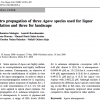
Autores:
Ramírez-Malagón R.
Borodanenko A.
Pérez-Moreno L.
Salas-Araiza M.
Nuñez-Palenius HG.
Ochoa-Alejo N.
Revista y/o libro:
Plant Cell, Tissue and Organ Culture
Volumen:
94, 201-207
Año:
2008
Sinopsis:
Some species of Agave are highly endangered due to overexploitation and inefficient propagation systems. The objective of this study was the establishment of reliable in vitro protocols for Agave propagation. For A. tequilana, 2,4-D-temporary pulses (exposure of explants for 1, 3 or 6 days) with concentrations of 2.3, 4.5, 6.8 and 9.0 mM were applied to apical shoot explants. For in vitro propagation of A. salmiana subspecies crassispina, A. duranguensis, A. oscura, A. pigmaea and A. victoria-reginae, a range of IBA levels (0.049, 0.49 and 2.46 lM) in combination with BA concentrations (0.44, 2.22, 4.44, 13.31 and 26.63 lM) were tested. Although axillary shoot production by different Agave species varied depending on the IBA to BA ratio, low concentrations of these growth regulators improved shoot production compared to those reported in other studies.